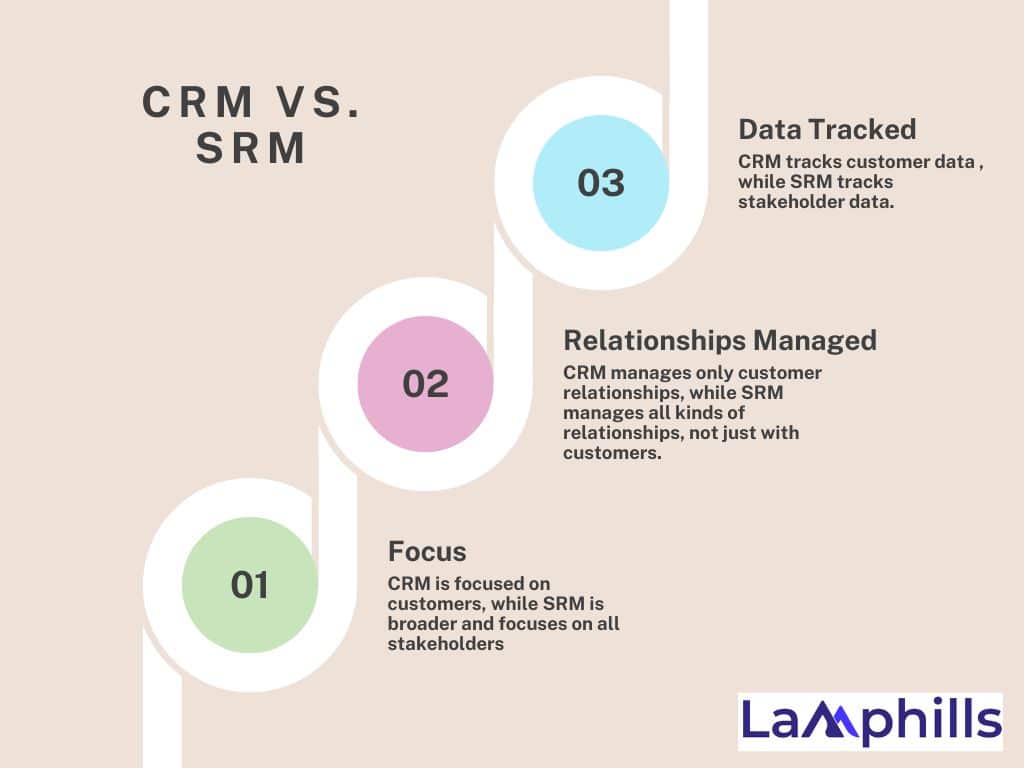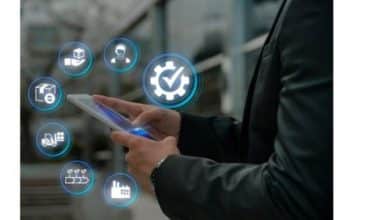When managing relationships in your business, you might hear two terms: CRM Vs SRM. They sound alike and are sometimes mixed up because both deal with managing relationships. However, they serve different purposes.
Customer relationship management (CRM) helps you manage interactions with your current and potential customers. On the other hand, stakeholder relationship management (SRM) helps you manage relationships with various people like suppliers, partners, investors, employees, and the community.
Both CRM and SRM are about managing relationships, but the groups they focus on are different. Knowing the difference will help you choose the right strategy for managing customer and stakeholder relationships.
In this article, we’ll explain each term, its similarities and differences, and when to use it. Keep reading to learn more.
Key Points.
- CRM focuses on managing customer relationships, while SRM manages relationships with everyone else, like suppliers and partners.
- Use CRM to improve customer loyalty and sales and SRM to keep all your business connections running smoothly.
- CRM helps you understand customers and grow sales, while SRM makes sure your suppliers, employees, and partners work together well.
- CRM is great for customer-related tasks, but SRM covers a wider group of people important to your business.
- CRM solves customer-related issues, while SRM helps prevent problems with suppliers, partners, and other key stakeholders.
CRM vs. SRM: Definition of Terms.
When I was helping a small fashion brand, I thought using a CRM to manage our customers was enough. But as we prepared for a new collection, I realized we had more than just customers to manage. Suppliers were late, and we had to coordinate with designers and investors.
That’s when I discovered Stakeholder Relationship Management (SRM). Unlike CRM, which only focuses on customers, SRM helped me manage everyone involved in the process. With SRM, I could track supplier timelines, update investors, and keep designers on the same page.
In the end, the launch went smoothly, and I realized that CRM is great for customers, but SRM is essential for managing all the important relationships.
Customer Relationship Management (CRM)
CRM is all about gathering information on how customers behave so you can understand what they want and like. This helps you offer a more personalized experience to each customer.
CRM focuses on finding new customers, managing campaigns, offering customer support, and building relationships after a sale. To make CRM work well, you’ll need CRM software. It helps you:
- Keep track of customer interactions
- Manage potential customers and sales
- Automate marketing efforts
- Offer personalized customer service
- Spot patterns in customer behaviour to improve your products and services
Stakeholder Relationship Management (SRM)
SRM, or stakeholder relationship management, is about managing interactions with important people connected to your company. The goal is to improve how your company communicates and engages with them.
SRM requires teamwork across different departments to handle relationships with various stakeholders and meet the company’s goals.
Besides having a plan for SRM, you also need SRM software. This helps you manage relationships effectively by providing:
- A single platform to store all stakeholder information and track interactions across different channels
- Data analysis to understand stakeholder preferences, needs, and behaviours
- Customized communication strategies to meet stakeholder expectations better.
Unlike CRM, SRM covers a wider range of people, not just customers. SRM software helps manage relationships with different stakeholders across the company, while CRM software mainly focuses on customer-related activities.
CRM vs. SRM: What’s the Difference?

Here are the major differences between CRM (Customer Relationship Management) and SRM (Stakeholder Relationship Management), explained in simple terms:
#1. Focus of Each System
CRM is focused on customers. It helps businesses manage relationships with their buyers, clients, or potential customers. The main goal is to improve customer satisfaction, increase sales, and keep customers loyal to the brand.
SRM is broader and focuses on all stakeholders. Stakeholders include anyone interested in the business, like suppliers, employees, partners, investors, or even government agencies. The goal is to manage all these relationships, not just those with customers.
#2. Type of Relationships Managed
CRM manages “only customer relationships”. It helps you track how customers interact with your business, what they buy, how often they visit, and their preferences. It’s mostly used for sales, marketing, and customer service.
SRM manages all kinds of relationships, not just with customers. It includes relationships with suppliers, investors, partners, and anyone else important to your business. For example, in a project, SRM can help you keep track of deadlines with suppliers, update investors, and collaborate with partners.
#3. Purpose
CRM helps you increase sales and improve customer loyalty. It helps you understand your customers better and personalize your approach to meet their needs. It also helps you follow up with potential leads to convert them into paying customers.
SRM helps you coordinate with all key players involved in your business or project. It’s used to make sure that everyone, from suppliers to employees, is on the same page and working smoothly together.
#4. Scope
CRM has a narrow scope because it only deals with customers. It’s great for businesses that sell products or services and build strong relationships with their buyers.
SRM has a *wider scope* because it deals with a larger group of people. It’s used when you need to manage multiple relationships that affect the success of your business, such as suppliers, partners, and investors.
#5. Risk Management and Problem-Solving
CRM is focused on solving problems related to customer management. It helps reduce customer complaints, improve service, and prevent customers from leaving. CRM manages the risk of losing customers, ensuring loyalty and continued business by keeping customers satisfied and engaged.
On the other hand, SRM addresses problems related to overall business operations. It helps avoid delays, miscommunication, and conflicts with different stakeholders. For example, if a supplier is late with deliveries, SRM can quickly identify the issue and prevent further problems. SRM manages risks across the entire business, ensuring smooth relationships with suppliers, investors, and other key players to avoid bigger issues down the line.
#6. Data Tracked
CRM tracks customer data, such as buying habits, communication history, and customer satisfaction levels. It helps businesses better understand their customers and improve sales efforts.
SRM tracks stakeholder data, such as contract terms with suppliers, partners’ deadlines, and investor expectations. It gives a broader view of how different stakeholders are affecting the business.
#7. Type of Interactions
CRM focuses mostly on transactional interactions, like purchases, customer service inquiries, or sales calls. The system is designed to help you close deals and provide good customer service.
SRM involves more complex, long-term interactions. It’s not just about sales but about keeping your suppliers, investors, and partners engaged and satisfied over time. SRM handles a wider range of tasks, from tracking supplier deliveries to managing investor expectations.
#8. Who Should Use Each System
CRM is best for businesses whose main focus is on *selling products or services* to customers. It helps manage customer relationships to boost sales and keep customers happy.
SRM is best for businesses or projects that involve *many different stakeholders*, like suppliers, partners, or investors. It’s important when you need to keep track of multiple relationships beyond just customers.
In summary, CRM is all about customers and ensuring their satisfaction, while SRM is about managing a wide range of people who contribute to the success of your business or project. Both are useful, but they serve different purposes.
CRM Vs. SRM- Similarities
Both CRM (Customer Relationship Management) and SRM (Stakeholder Relationship Management) are about building strong connections with important people, whether they are customers or other key partners. Here’s how they are similar:
| Category | SRM (Stakeholder Relationship Management) | CRM (Customer Relationship Management) |
| Focus on relationships | SRM works on building relationships with different stakeholders. | CRM works on building and keeping relationships with customers. |
| Managing data | SRM involves gathering and organizing data to understand stakeholders. | CRM involves gathering and organizing data to understand customers. |
| Communication and engagement | SRM uses communication to engage with stakeholders to get results. | CRM focuses on communicating and engaging with customers. |
| Teamwork | SRM values working together with stakeholders | CRM values working together with customers. |
How CRM and SRM Help Improve Supply Chain Management
Here’s how you can use customer relationship management (CRM) and stakeholder relationship management (SRM) together to make your supply chain more efficient:
#1. To Make Demand Forecasting and Plan More Accurate
To predict demand correctly, you need to make sure your suppliers can meet both current and future customer needs. This helps you plan better.
When you use both CRM and SRM software together, it becomes easier to manage inventory, shorten delivery times, and improve your supply chain.
For instance, CRM software provides useful information about customers’ likes, buying habits, and demand trends.
By sharing this information with your SRM team, they can choose the right suppliers, negotiate with them, and ensure they deliver on time to meet your needs.
#2. To Improve Team Collaboration
By connecting CRM (Customer Relationship Management) and SRM (Stakeholder Relationship Management) software, you make it easier for your sales, marketing, and procurement teams to share data, communicate, and work together.
For example, when your sales team gathers customer feedback using the CRM tool, they can update the CRM software. This sends an automatic message to the SRM team, telling them to find suppliers who can meet customer needs.
Likewise, when the SRM team updates information about suppliers—like performance, pricing, and delivery—it shares this information with the CRM team, which helps the CRM team give accurate information to customers.
Combining CRM and SRM systems also helps everyone see the whole supply chain more clearly. The SRM team can access real-time data on customer orders, inventory, production, and supplier performance, which is shared across both systems.
This shared information helps the SRM team make better decisions, fulfill orders efficiently, and match customer demands with supplier capabilities.
#3. To Monitor and Improve Supplier Performance
CRM systems can track and analyze customer feedback, like complaints and satisfaction levels. This feedback helps you spot problems with product quality, delivery delays, or customer service.
By sharing this information with SRM teams, you can quickly fix any issues with suppliers, work on improvements, and make sure you always meet customer expectations.
Note: If you’re managing both customers and other important business relationships like suppliers or partners, combining your CRM and SRM systems can make things a lot easier. By integrating these systems, you can improve communication, track all your interactions in one place, and prevent delays or miscommunication.
To help you get started, we’ve created a simple step-by-step guide below. Use this guide to learn how to bring your CRM and SRM together for a smoother, more efficient workflow.
CRM Vs. SRM -Software
CRM Software and SRM Software are tools businesses use to manage relationships, but they focus on different groups of people and serve different purposes. Let’s break it down.
What is CRM Software?
Customer Relationship Management (CRM) software is designed to help businesses manage customer relationships. It helps track interactions, sales, and customer service efforts to improve customer satisfaction and boost sales. CRM software is commonly used to store customer contact information, record conversations, and track customers’ buying habits.
Examples of CRM Software:
- Salesforce is a popular CRM that helps companies track customer interactions, manage sales pipelines, and follow up on leads.
- HubSpot CRM: Another well-known CRM that offers free tools to track customer interactions, automate emails, and improve marketing efforts.
- Zoho CRM: This tool helps small and large businesses manage customer data, sales activities, and communication.
What is SRM Software?
Stakeholder Relationship Management (SRM) software: is broader than CRM. It helps businesses manage relationships with “all stakeholders,” not just customers. Stakeholders can include suppliers, investors, business partners, and even internal teams. SRM software is designed to track and manage all these different relationships and ensure everyone is working together smoothly.
Examples of SRM Software:
SAP Ariba: This is a well-known SRM software that helps companies manage supplier relationships, track supplier performance, and streamline procurement processes.
Ivalua: This tool helps businesses manage suppliers and partners, focusing on procurement, sourcing, and supplier collaboration.
Oracle Supplier Relationship Management: is part of the Oracle suite and helps businesses track supplier interactions, manage contracts, and improve supplier performance.
The Differences Between SRM and CRM Software
| Category | CRM Software | SRM Software |
| Designed to manage | The sales process – a set routine that stays mostly the same for each customer or product. | Manages relationships with different stakeholders, which require more flexibility. |
| Purpose | To guide customers through the sales process. | To build and maintain relationships with stakeholders. |
| Goal | To increase profits. | To find and create solutions that benefit both the company and stakeholders. |
| Type of cycle | Linear – follows a set path. | Cyclical – repeats and adapts over time. |
| Timeline | Short-term. | Long-term, often lasting for years. |
| Used to track | Revenue and sales. | Interactions and relationships. |
| Approach | Reactive – responds to problems when they happen | Proactive – plans for issues before they arise. |
| Best For | Companies with stable, predictable customer relationships | Organizations with complex, multi-stakeholder relationships |
| Using for Stakeholder Management | Can be customized but may involve risks | Specifically designed for stakeholder management, ready to use. |
In short, if you need software to focus on customers, CRM is the right choice. But if your business involves managing relationships with many different groups like suppliers, investors, and business partners, then SRM software is what you need to keep everyone connected and the business running smoothly.
Are CRM and SRM Systems the same?
No, CRM and SRM systems are not the same.
For example, I used our CRM to manage customer purchases, send them exclusive offers, and monitor their feedback, which helped build customer loyalty. However, it didn’t help with other important relationships, like suppliers or partners. In the fashion business, I needed SRM to handle suppliers, designers, and investors. SRM helped me track delivery schedules, ensure designers met deadlines, and keep investors informed, making the entire process run more smoothly.
Here are three other reasons why they are not the same:
1. Hidden costs
CRM software is made to handle customer relationships, not stakeholder relationships. If you try to use a CRM system for stakeholders, you’ll need to add extra tools and customizations, which can increase costs and maintenance.
2. Low success rates
CRM tools focus on keeping customers happy and loyal. If you use them to manage relationships with suppliers, partners, or employees, it won’t improve those connections because that’s not what CRM software is built for.
3. Slower workflows
CRM software has features like lead management and sales forecasting that SRM tools don’t have. However CRM systems lack important functions for managing suppliers and partners. Without SRM features, your work process can become slow and inefficient, leading to more manual tasks and lower productivity. Communication and collaboration with stakeholders will also become more difficult.
Conclusion
In conclusion, while both CRM and SRM help manage relationships and improve communication, they focus on different groups of people and serve different purposes. CRM software is perfect for managing customer relationships and driving sales, while SRM software is essential for handling a broader range of stakeholders like suppliers, employees, and partners.
The choice between CRM and SRM depends on your business’s needs, goals, and how many different relationships you need to manage. Understanding these differences will help you choose the right tool for your business.
Frequently Asked Questions.
What does SRM stand for in CRM?
SRM stands for Stakeholder Relationship Management. SRM is designed to help you communicate more effectively with stakeholders. It keeps track of all types of communication, like phone calls, emails, meetings, video calls, events, and social media interactions. Some SRM systems also include tools to manage complaints.
What is the difference between SAP CRM and SAP SRM?
SAP CRM is a set of tools that helps you manage your relationships with customers better. SAP SRM, on the other hand, is a set of tools that helps you manage your relationships with suppliers better.
What are ERP, CRM, and SRM?
ERP stands for Enterprise Resource Planning. It is a system that uses a shared database to manage different parts of a business, including SRM and CRM. SRM means Supply Chain Management and CRM stands for Customer Relationship Management. Both CRM and SRM are part of ERP. R/3 is a type of software setup used to run ERP systems.
What’s the difference between SCM and CRM?
CRM (Customer Relationship Management) is software that helps you handle the entire sales process, from the first contact with a customer to the closing of the sale. SCM (Supply Chain Management) is software that helps businesses manage their supply chain, including buying raw materials, making products, and shipping them to customers.
Which is better, SAP or CRM?
SAP is a great option for big companies with complicated sales processes. The SAP CRM system is strong and can manage a lot of data. It’s also a good choice for businesses in regulated industries like healthcare and finance because SAP provides special compliance features that other CRMs may not have.
Is CRM the same as an ERP tool?
No. While both CRM and ERP have similar advantages, they are not the same. What’s the difference? CRM helps with customer-facing tasks like sales, customer service, and marketing, while ERP helps with internal tasks like accounting, operations, and human resources.”
Similar Articles.
What Is Relationship Marketing? All You Need To Know
Building A Strong Relationship with Journalists: Mastering Media Relations
How to Create an Effective Media Plan: Examples and Template






